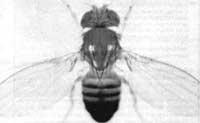Hermann Muller
This American biologist was born a hundred years ago in New York, on December 21, 1980. He studied in the Bronx neighborhood at Morris College, where he created a science club.
1907. In 1918 he moved to Columbia University with the help of a scholarship and there he studied until obtaining a doctorate in 1916. In 1911, under the direction of Thomas Morgan, he began to study the genetics of the fruit fly. He had the opportunity to see how mutations were formed in the fly, but Muller wanted to accelerate the mutations. It did not seem good that the biologist had to wait long.
When Muller began to investigate his way he was looking for methods to accelerate the generation of mutations. In 1919, for example, he observed that by increasing the temperature mutations increased. He later discovered that it was not the result of the general excitation of the genes. And it is that there was always only one gene attacked, while the gene that was on the other chromosome of the pair was normally maintained. That is why Muller, pushed by heat, thought that the changes were produced at the molecular or internal level of the molecule.

It occurred to him to use X-rays to accelerate the mutations. They were more violent than normal heat and, directing the ray to a chromosome, would only affect a specific point. In 1926 he realized that it worked properly, since X-rays proliferated mutations.
This phenomenon had its advantages. On the one hand, with many mutations, biologists could have enough material to analyze them without waiting long. On the other hand, it showed that there was nothing spiritual that influenced the mutations, since the biologist had the possibility of initiating the mutation. Later, botanist Albert Blakle showed that in addition to radiations, conventional chemicals were able to initiate mutations.
In the American depression, Muller suffered a crisis and arrived in Europe. He worked in Berlin and the Soviet Union, but he left the Soviet Union because he did not genetically fit Lysenko's ideas.
Muller saw in his research that most of the mutations were harmful. Only useful or advantageous mutations favored evolution and the harmful tended to destroy. Therefore, if evolution has to follow, it is not possible to have many harmful mutations. Otherwise, too many defective individuals would appear for the species to continue.
Muller worked a lot on the unnecessary X-ray in diagnosis and medical therapy. He knew that with excessive doses of X-ray, cancer was produced. For Muller, cancer was a form of mutation by which the normal cell could become a cancer cell.
However, Muller wanted to see that the gonads were subjected to positive mutations by X-ray exposure, both in medical and industrial conditions.
Since the end of World War II, Muller worked intensely to vindicate the danger of the mutations generated by radioactivity as a result of nuclear sessions. Radioactivity mutations are more frequent and Muller clearly saw the damage it can cause in humanity.
On the other hand, Muller, like before Francis Galton, expressed support for taking eugenic measures to improve the genetic health of humanity, to apply the genetic laws of inheritance in human beings. He defended the theoretical idea of creating sperm banks to conserve geniuses.This topic, however, has been and is quite dangerous. Unfortunately, the most enthusiastic advocates of eugenics are usually not scientists and use scientific language to achieve their racial goals.
Muller, however, returned from Europe to North America where he was given the chair at the University of Indiana. In 1946 he won the Nobel Prize in Medicine. He died in Indianapolis on April 5, 1967.
Buletina
Bidali zure helbide elektronikoa eta jaso asteroko buletina zure sarrera-ontzian











